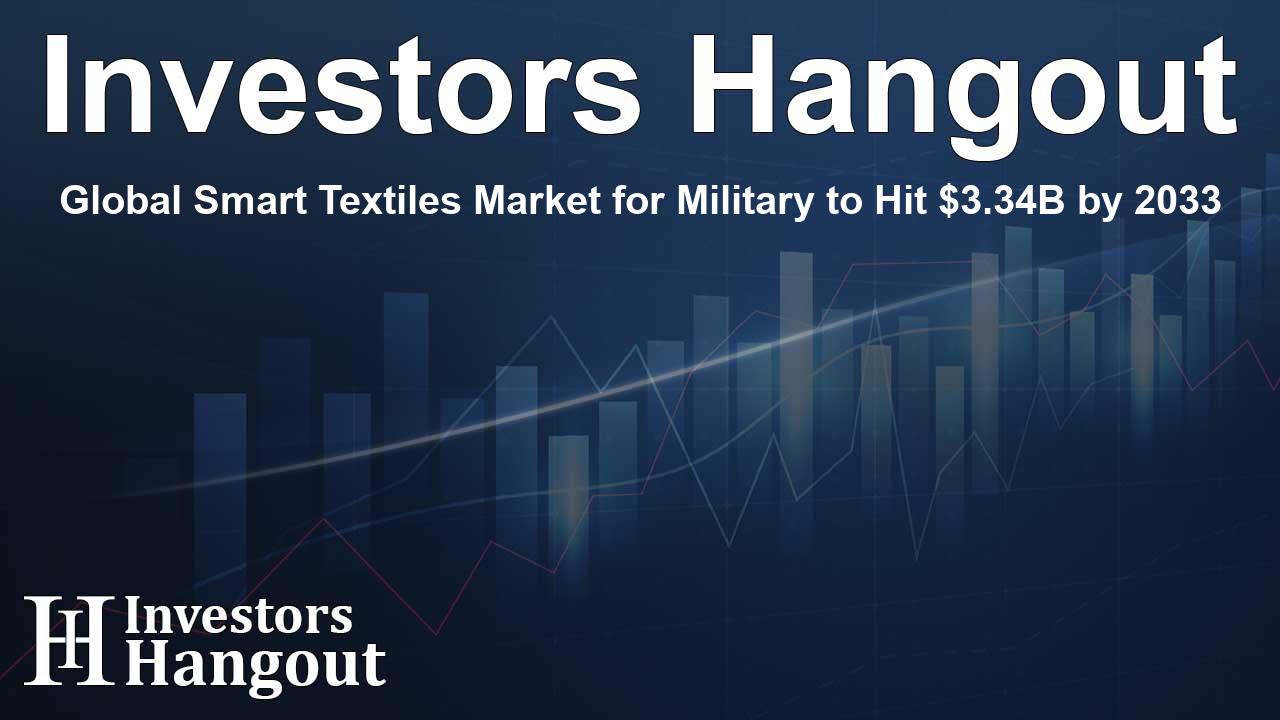Global Smart Textiles Market for Military to Hit $3.34B by 2033

Smart Textiles: The Cutting-Edge of Military Innovation
Smart textiles represent an innovative leap in fabric technology, capable of sensing and responding to various environmental factors. These textile structures blend advanced materials and technologies, transforming traditional fabric into responsive surfaces that can adapt to the needs of military personnel.
The Beginnings of Smart Textiles in Defense
Initially emerging in the realm of high-performance gear, smart textiles are increasingly playing a vital role in enhancing military capabilities. These intelligent materials can monitor health metrics, adjust to climatic conditions, and improve the wearer's comfort while providing essential protective features.
Revolutionizing Military Apparel
Incorporating nanotechnology and electronics, smart textiles have become integral to modern military uniforms. They reduce the logistical burden on troops by minimizing the number of tools needed for various tasks. Soldiers equipped with these textiles can operate more efficiently, leading to enhanced operational readiness.
Market Dynamics Influencing Growth
The evolving landscape of global defense and military modernization initiatives significantly drives the demand for smart textiles. Heightened geopolitical tensions and security concerns have led to increased defense budgets in nations like the United States, United Kingdom, China, and India. This trend indicates a commitment to adopting advanced technologies, including smart textiles, to enhance military effectiveness.
Advancements in Technology and Manufacturing
Recent advancements in textile and manufacturing technologies have opened up exciting opportunities in the smart textiles market. Designers and engineers are integrating sophisticated components such as conductive yarns, sensors, and micro-electronics into fabrics, allowing for robust applications in various military contexts. For instance, smart textiles can now potentially change color, monitor health indicators, and regulate temperature, significantly enhancing garment functionality.
Regional Insights into Smart Textiles Development
Regionally, Asia-Pacific is at the forefront of the smart textiles market, showcasing impressive growth and investment in military applications. The defense sector is rapidly adopting wearable technologies and smart systems, reflecting a dedicated effort to bolster military capabilities. Innovations such as artificial cloak skins are being developed to allow personnel to blend into their surroundings effectively.
Europe’s Approach to Military Smart Textiles
Similarly, Europe is experiencing a surge in smart textiles development, with particular focus on injury prevention and health monitoring for service members. The British Army is utilizing data science to improve overall soldier performance and well-being, further embedding smart textile solutions into their operational framework.
Prominent Players and Their Contributions
The competitive landscape of the smart textile market includes significant entities such as DuPont, L. Gore and Associates Inc., and BAE Systems PLC. Each company contributes uniquely to developing state-of-the-art smart textiles tailored for military applications, ensuring a diverse range of products that meet the evolving needs of defense.
Recent Innovations in Smart Textile Technology
Noteworthy advancements include the introduction of first-of-their-kind materials, like Gore-Tex stretch fabric for military rain jackets and fire-retardant uniforms specifically designed for the Royal Australian Navy. These innovations exemplify the industry's direction toward integrating safety, comfort, and performance in military gear.
Market Forecast and Potential
The smart textiles for military market is projected to grow dramatically, with estimates suggesting a rise from USD 413.15 million and reaching up to USD 3.34 billion in the forthcoming years. The market's expansion indicates a compound annual growth rate (CAGR) of 26.14%, with specific segments such as temperature monitoring leading the charge.
Conclusion: The Future of Military Attire
The future of military apparel depends significantly on the ongoing advancements in smart textiles. As technology evolves, the potential to improve soldiers' operational efficiency, health, and safety will only increase. The continued investment in this field signifies a commitment to modernize military capabilities through innovative textile solutions.
Frequently Asked Questions
What are smart textiles?
Smart textiles are advanced fabrics embedded with technologies that allow them to sense and respond to environmental changes.
How is the smart textiles market projected to grow?
The market is expected to grow significantly, from USD 413.15 million to USD 3.34 billion, driven by advancements and military modernization.
Which regions are leading in smart textiles development?
Asia-Pacific currently leads in this market segment, with Europe showing robust growth as well.
What technologies are included in smart textiles?
Smart textiles use technologies such as sensors, microelectronics, conductive yarns, and more to enhance their functionalities.
Who are the major players in the smart textiles market?
Key players include DuPont, L. Gore and Associates Inc., BAE Systems PLC, and several others, each contributing innovative products.
About The Author
Contact Dylan Bailey privately here. Or send an email with ATTN: Dylan Bailey as the subject to contact@investorshangout.com.
About Investors Hangout
Investors Hangout is a leading online stock forum for financial discussion and learning, offering a wide range of free tools and resources. It draws in traders of all levels, who exchange market knowledge, investigate trading tactics, and keep an eye on industry developments in real time. Featuring financial articles, stock message boards, quotes, charts, company profiles, and live news updates. Through cooperative learning and a wealth of informational resources, it helps users from novices creating their first portfolios to experts honing their techniques. Join Investors Hangout today: https://investorshangout.com/
The content of this article is based on factual, publicly available information and does not represent legal, financial, or investment advice. Investors Hangout does not offer financial advice, and the author is not a licensed financial advisor. Consult a qualified advisor before making any financial or investment decisions based on this article. This article should not be considered advice to purchase, sell, or hold any securities or other investments. If any of the material provided here is inaccurate, please contact us for corrections.
